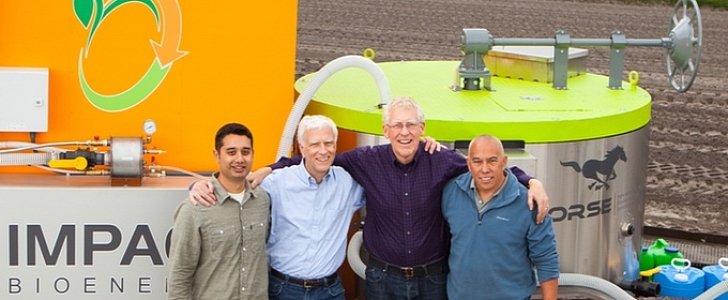A report by United Nations Environment Program (UNEP) and the World Resources Institute (WRI) has found that about one-third of all food produced worldwide gets lost or wasted in food production and consumption systems. We’re talking about throwing away $1 trillion every year. What if we could use a good part of that to create biofuel and fertilizer, instead?
If you were to convert all that amount of food into calories, it would mean that approximately 1 in 4 calories intended for consumption is never actually eaten. That sounds like a lot of waste, if you ask us, especially in the light of 21st century’s world hunger and poverty facts.
Sure, it’s not the first time we hear about the possibility to change biodegradable waste for composting or as a resource for heat, electricity, and fuel using incineration or anaerobic digestion. However, what this device does is that it brings the processing device to your home. With the size and price of a car, Horse is a “living” machine that eats food scraps and makes energy and plant food using microbes with zero waste.
You can actually get off the grid with this device while you get rid of organic waste from your trashcan. The creator’s vision is for people to become more self-sufficient. Any person should be able to produce renewable energy on their property, to fertilize their own or a nearby garden or farm and to grow food and flowers.
According to its creators, Horse will consume 25 tons per year of scrap food, beverages, fat, and paper products. It can create 5,400 gallons per year of liquid fertilizer, plus up to 37 Mw-hours of raw energy. As renewable gas, that’s 12 Million BTU per year (4.3 MW-hours of this energy is electrical output). How do you translate these numbers?
Well, with it charged at full capacity, you’d be able to go 20,100 miles in a BMW i3 per year or 14,800 miles in a Nissan Leaf or 10,700 miles in a Tesla Model S.
Here’s how the team describes their project:
“This is how Henry Ford conceived the Model T. This is how Doc Brown conceived the Flux Capacitor. They inspired us. Ford's vision was a horseless carriage constructed of the 'best materials, by the best people available, using the simplest designs that technology can devise'. Our vision is a HORSE with the same characteristics. Now a century later we are taking it up a notch with biomimicry – a machine designed to behave as nature intended."
Sure, it’s not the first time we hear about the possibility to change biodegradable waste for composting or as a resource for heat, electricity, and fuel using incineration or anaerobic digestion. However, what this device does is that it brings the processing device to your home. With the size and price of a car, Horse is a “living” machine that eats food scraps and makes energy and plant food using microbes with zero waste.
You can actually get off the grid with this device while you get rid of organic waste from your trashcan. The creator’s vision is for people to become more self-sufficient. Any person should be able to produce renewable energy on their property, to fertilize their own or a nearby garden or farm and to grow food and flowers.
According to its creators, Horse will consume 25 tons per year of scrap food, beverages, fat, and paper products. It can create 5,400 gallons per year of liquid fertilizer, plus up to 37 Mw-hours of raw energy. As renewable gas, that’s 12 Million BTU per year (4.3 MW-hours of this energy is electrical output). How do you translate these numbers?
Well, with it charged at full capacity, you’d be able to go 20,100 miles in a BMW i3 per year or 14,800 miles in a Nissan Leaf or 10,700 miles in a Tesla Model S.
Here’s how the team describes their project:
“This is how Henry Ford conceived the Model T. This is how Doc Brown conceived the Flux Capacitor. They inspired us. Ford's vision was a horseless carriage constructed of the 'best materials, by the best people available, using the simplest designs that technology can devise'. Our vision is a HORSE with the same characteristics. Now a century later we are taking it up a notch with biomimicry – a machine designed to behave as nature intended."
